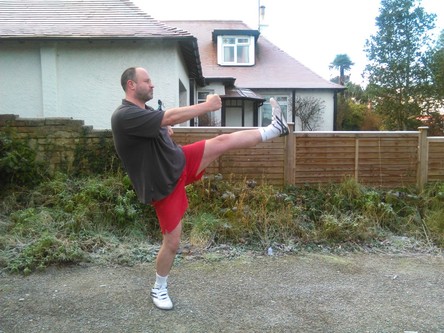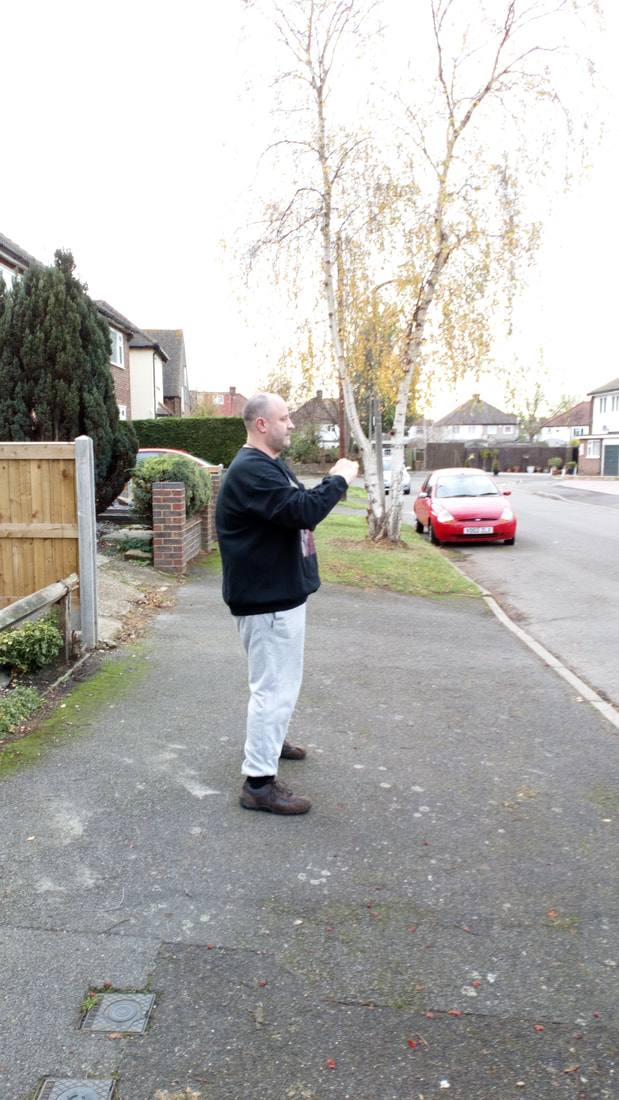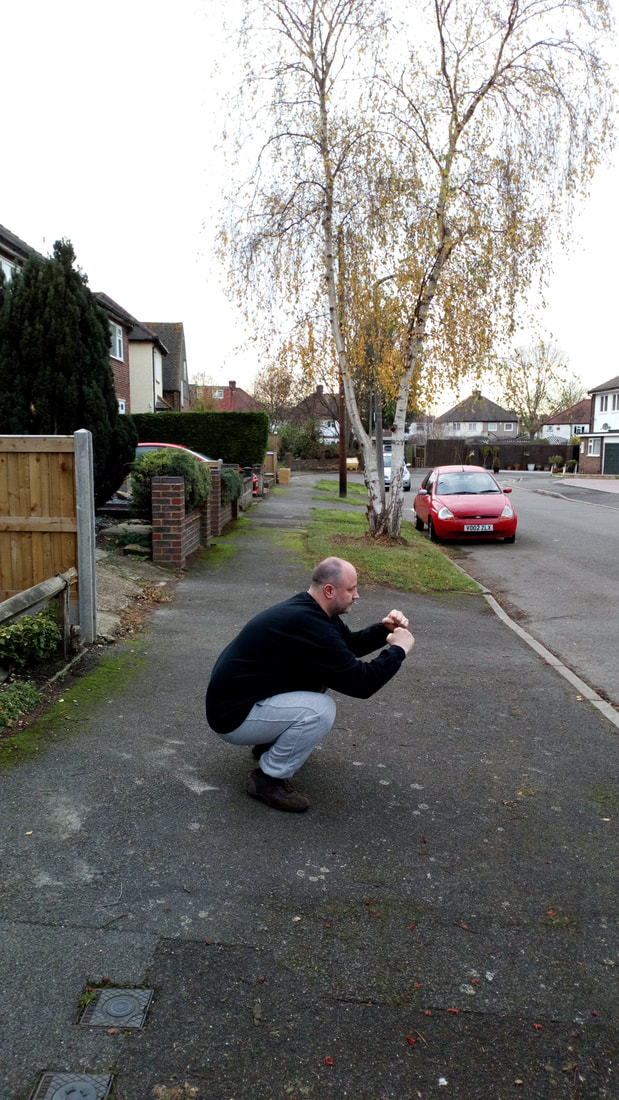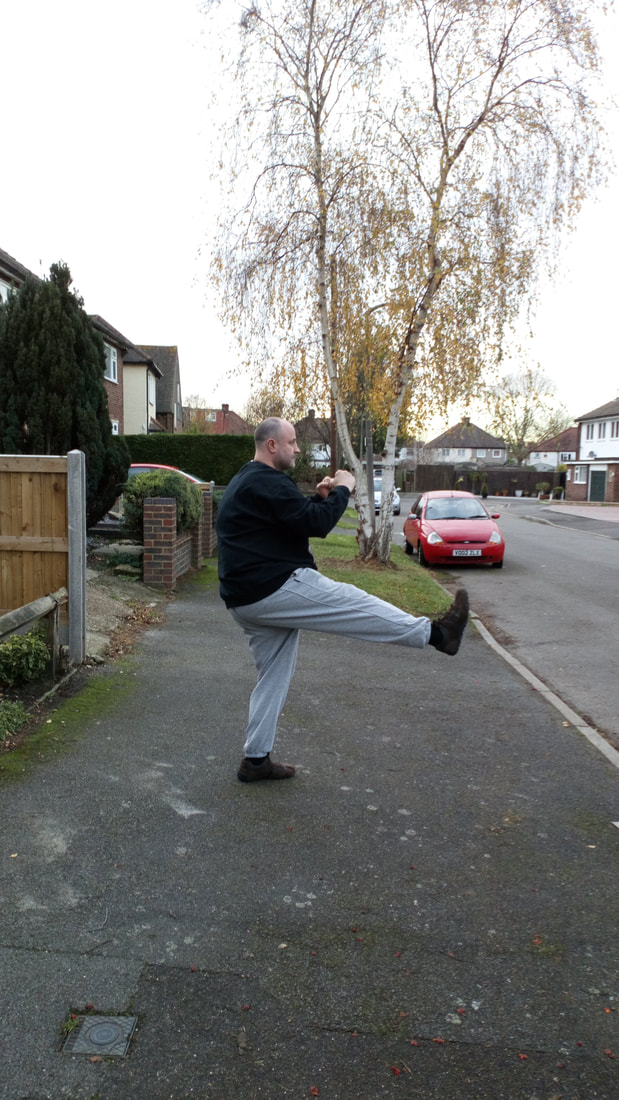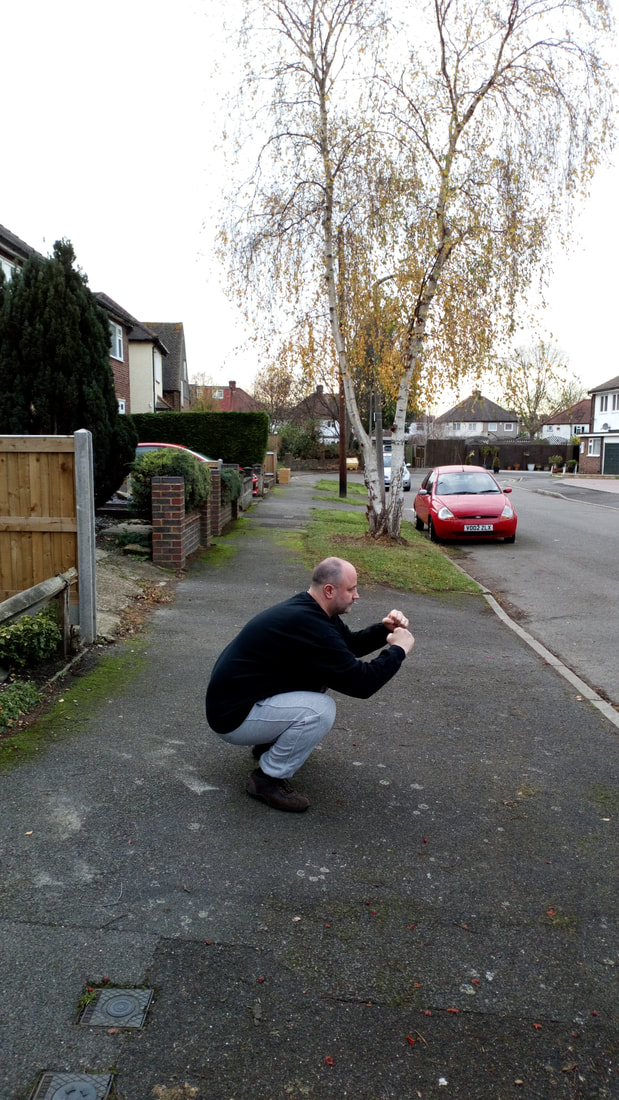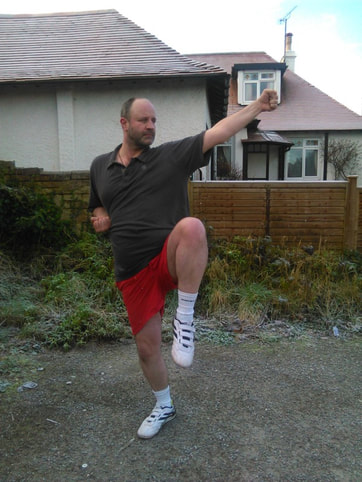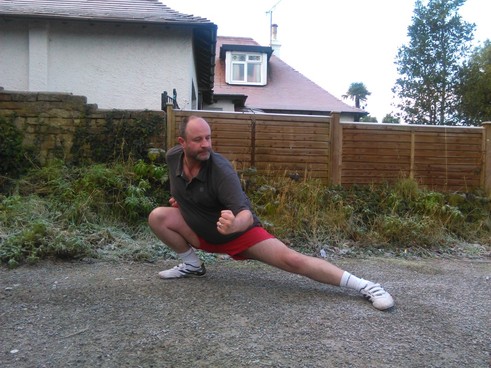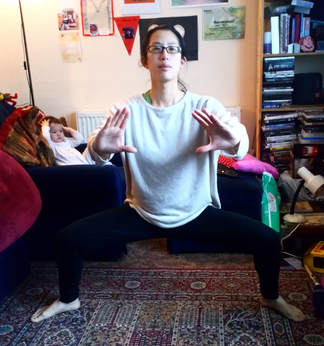Hakka Internal Kicking is a Practical Science
By Shifu Adrian Chan-Wyles (PhD)
Kicking within traditional Chinese martial arts, although a distinct aspect of combat-skill, is nevertheless linked to balance, stability, standing still correctly (i.e. strongly holding static ‘stances’), moving around efficiently (i.e. correctly performing transitions that link static stances ‘together’), effective evasion, advanced power generation (and transmission), elbowing, shoulder striking and punching, etc. The legs link the body to the ground, and must be suitably conditioned over years to be strengthened appropriately for the structural demands of a particular gongfu style. Within the Ch’an Dao System the style is Longfist. This requires running up and down hills (as found in the Hakka areas of Hong Kong’s New Territories), with and without carrying heavyweights upon the back (usually in the form of a ‘weighted’ rucksack). Obviously, this arduous exercise is carried-out in a hot and humid climate (in Hong Kong), and is designed to strengthen the cardiovascular system as well as building stamina, strength and endurance in the leg structures (i.e. bones, ligaments, tendons, joints, muscles, nerve transmission and enriched blood circulation). This also includes the development of leg co-ordination, and the ability for the mind to become fully ‘aware’ of bodyweight as it drops through the leg structures into the ground (through the feet) and ‘rebounds’ with every step back up through the body. The structures of the legs must also be ‘loosened’ through focusing the mind upon the breath, and wilfully ‘relaxing’ any and all unnecessary muscular tension. When the leg muscles are free of any unnecessary tension, then the ligaments and tendons can be systematically and logically ‘stretched’. However, ‘looseness’ in the leg structures is achieved not through stretching (which serves as an extra-conditioner), but rather by the development of ‘intention’ in the mind, and the ability to ‘relax’ unnecessary tension, and then keep any unnecessary tension from arising in the muscle mass. The Ch’an Dao System also uses squat-kicking which has historically evolved from the ethnic Hakka practice of crouching-down on the haunches. Ethnic Hakka people often crouched in this manner to eat food, or to evade an enemy. Entire Hakka armies would collectively crouch for extended period of times in the long grass and remain out of sight of an enemy. At a given signal, these Hakka armies would suddenly ‘stand-up’ in exact military formation, and give the impression that an entire army had materialised out of thin air! Sometimes this ‘illusion’ helped to win battles against numerically superior (but superstitious) enemies.
As a consequence, the technique of each type of kick must be thoroughly learned. This technique is comprised of the shape, positioning and movement of the leg structure as power is generated from the ground and transmitted to the foot, which is conveyed into the opponent at the point of contact. Each kick can be technically correct and delivered through an ‘external or ‘internal’ methodology. An external kick requires speed of muscle contraction and the generation of muscular force gained from said contraction. This type of kicking is dependent upon the fitness of the muscles involved, and as the leg muscle becomes tired, the accuracy and strength of the kick begins to diminish. Although a limited method for producing power, every student must master this power-generating technique before being able to cognitively and physically transition to ‘internal’ kicking. This why in the Ch’an Dao System students train to the brink of physical exhaustion as a means to understand the inherent limitations of the ‘external’ method. The internal method of kicking is a matter of power-generation and power-transmission through the centre-mass of the bone structure. This advanced method is considered to be the accumulation of qi energy in the mind and body, which is gathered through sincere training and the development of a virtuous character. Within Western thinking, this method is defined as an indepth psychological appreciation of how a human-body exists within a gravitational field, and how gravity operates within and through the interior of the bones. Without this awareness there cannot be a development of ‘internal’ kicking. Instead of relying upon ‘localised’ muscular force, the internal kick emits the entire bodyweight through the foot as it makes contact with the opponent. Muscles are not suddenly ‘tensed’ as in the ‘external’ method, but rather act through continuous ‘ripples’ or gentle contractions that flow throughout the entire body. This is the advanced use of muscular contractions to retain the bones and joints in a continuously ‘aligned’ position. When the posture is naturally aligned, bodyweight drops into the ground unhindered (through the centre of the bones), and when it hits the ground – rebounds back-up through the centre of the bones. In this way, a concentrated and dynamic bodyweight replaces the requirement for sudden muscular contractions as a means to generate power. When an internal kick strikes an opponent, the entirety of the bodyweight inherent in the technique, penetrates the target in a highly concentrated manner. This serves to generally by-pass superficial bodily structures and instead penetrates the opponent’s neural network. This immediately affects balance, timing, co-ordination, the ability to read a fight correctly and generate a retaliatory response. If the penetrating power is precise, the opponent will lose all strength in the legs and either wobble or fall down. Kicks to the head might well cause unconsciousness if delivered properly. If the attacking leg is captured by the opponent, the sudden transmission of all the bodyweight into the extended limb, will cause that limb to become so heavy that it drops to the ground, causing the opponent to let go, or follow the leg to the ground and expose his-her head to further attack.
Knee-lifting is prominent in both Northern Longfist and Old-Style Yang Taijiquan (both found in the Ch’an Dao System). Knee-lifting is both a static block, a transitional deflection and a dynamic (knee) strike (a technique also found within Muay Thai). If executed correctly, the anchoring foot and leg is ‘rooted’ firmly to the ground, making it very difficult for an opponent to ‘move’ the defender – whilst the ‘lifting’ leg can be used to block and deflect incoming kicks and punches (as the raised-knee must travel higher than the pelvic girdle). This Longfist method frees the hands and presents a very strong but ‘high’ combat stance. Every Longfist practitioner must be able to kick accurately to the throat, lower jaw, upper jaw, and temple, as well as to the side and back of the skull without hesitation, and without losing balance or power-production. The knee may be raised fast or slow, but must always be used to dominate the opponent (even when the practitioner is having to defend a vigorous attack). A knee can be returned smartly to the ground, with the descending foot used to ‘stamp’ on the opponent’s shin and lead-foot. A raising knee is also part of the Ch’an Dao System’s extensive use of the rising flat-foot strike to the testicles (which are usually left unguarded in modern combat-derived martial arts). If possible, in a real fight the groin-kick must be delivered as soon as possible to bring the opponent’s head down in a reflex action. Once the head is lowered, the same foot that has struck the groin can be immediately ‘switched’ from the lower area to the upper area (again, without a break in the flow of movement or power). An advanced practitioner can easily vary the amount of power produced in the attacking leg and foot, depending upon the seriousness of the engagement, without compromising personal safety. When teaching students, the groin kick is delivered during developmental sparring as a strike to the inner-thigh area. Bending the legs slightly creates internal iron vest, whereby all the bodyweight becomes momentarily ‘focused’ at the point of the leg being struck by the opponent’s limb. The opponent experiences the struck area as if it were made of concrete, as well as the simultaneous ‘rejection’ of their own generated force so that it is pushed back into their body – causing pain, disruption of balance, and confusion. The legs and feet, when fully mastered through awareness and movement, possess the ability to be both ‘light’ and ‘heavy’, ‘fast’ and ‘slow’, and any combinations of these attributes. This leads to the ability of placing the feet and legs into an exact position that disrupts the opponent’s ability to move, stand still, and generate power. In fact, any attempt to by the opponent to move leads to a loss of balance and a sense of being ‘tripped’ or ‘uprooted’.
With extended back stances (such as Snake Creeps Down found in Taijiquan, and Eagle Swoops Down found in Eagle Claw Longfist), the weight is placed in the back (bent) leg and channelled into the ground through the heel and sole area. The extended leg is ‘elongated’ through relaxation and placement. The practitioner must develop the agility to ‘drop’ into, and ‘rise’ out of this stance with a smooth transition of bodyweight, which maintains balance, co-ordination and power. This is a major gongfu skill which probably has its origins within the thought of traditional Chinese medicine (TCM) and various related systems of associated Daoist thought. The concept of ‘qi’ (氣) is much misunderstood in the West, often erroneously associated with the ‘holy spirit’ as found in the Judeo-Christian religion. Qi within the context of Chinese cultural development has no relation to Western religious thought, and cannot be associated with it. Qi is a Chinese scientific concept developed over thousands of years of research and observation. In essence, qi stands for ‘breath’, ‘air, ‘compressed steam’ (as found in a boiling pot of water covered by a lid), ‘fire’, the transmission of ‘heat’, the cooking and digestion of ‘food’ and the processing, purification and ingestion of ‘water’. It can also be used to refer to ‘cloud’, ‘mist’ or ‘fog’, etc, and suggests a link between the inner biological processes that rely upon the intake of oxygen (and expulsion of carbon dioxide) with the outside world. Air is breathed in and sustains life. However, as the ideogram for ‘qi’ features a cauldron full of rice boiling in water over a fire, the concepts of ‘gravity’, ‘mass’ and ‘weight’ are also present. The TCM theory is that the body is comprised of an extensive network of qi energy channels (each linked to, or traversing through a particular organ or set of organs), which carry oxygen and nutrition throughout the body, and which also clears away waste (to be expelled through the outward breath, sweating and other processes). Of course, these qi energy channels correspond to blood vessels and the neural network that carries bio-electrical energy to and from the brain, and through the spinal column to the extremities and back. Qi channels can be constricted by poor posture, bad diet and deficient lifestyle choices, but through appropriate exercise, these channels can be ‘opened’ and ‘strengthened’. This is the case with the drop-down stances found in traditional Chinese gongfu.
Horse Stance training is a vital part of any internal kicking training. This is because the awareness must fully penetrate the bone, muscle, ligament and tendon structures of the legs, and become fully conversant with the unhindered ‘dropping’ of bodyweight through the centre of the bones, and how a tired muscle can be further ‘relaxed’ through the release of tension as an ‘act of will’, whilst retaining the integrity of the low Horse Stance. When a single leg is used to kick, the ‘rooting’ (non-kicking) leg must firmly grip the floor through the base of the foot. This is the exact and precise awareness of how bodyweight drops into the floor through the foot, and how a ‘rebounding’ force is automatically generated which travels back into the foot and up the centre of the leg bones. Without this ‘internal’ awareness gained through holding deep stances for long periods of time, there can be no ‘internal’ kicking. It is important to hold these postures and to use the musculature to its fullest extent, before the realisation occurs of how the bones and joints can hold their own structure with the minimum of muscular support. When perfecting these strengthening and endurance exercises, the ability to ‘re-distribute’ the burden of effort around the leg structure is important. Initially this process involves the effort being ‘moved’ around the musculature, but eventually involves switching the effort from the musculature and into the bone structures themselves. This mirrors exactly how an experienced and mature gongfu practitioner transitions from external kicking and into the advanced ability of internal kicking. Throughout this exercise, the mind must remain calm and expansive regardless of any physical or emotional hardship caused by the training, with the Horse Stance remaining both ‘stable’ and ‘rooted’ throughout.
©opyright: Adrian Chan-Wyles (ShiDaDao) 2017. |
